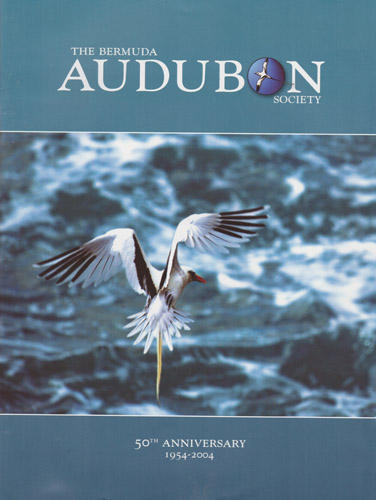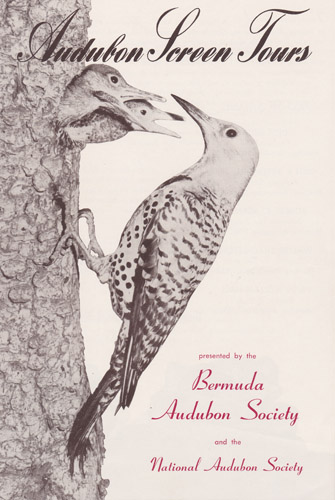The Bermuda Audubon Society is the island’s oldest environmental organization, established in 1954 to address two growing environmental concerns. The first was the threatened extirpation of the Eastern Bluebird on Bermuda following the death of the cedar forest and the removal of the dead trees, which contained the natural cavities in which it nested. The second was the official Government policy of the time to fill in Bermuda’s marshlands and ponds for mosquito control by using them as dumping grounds for garbage. But it was also a time of hope, because the Cahow had just been rediscovered in 1951.
The society was inspired by the National Audubon Society of North America, which was named after the famous ornithologist and bird painter, John James Audubon. The charter members consisted of Patricia Browne (later Benbow), Stanley and Sybil Gascoigne, Louis Mowbray, Ambrose and Babs Gosling, Jerome and Betty Hollis, Mabs Cooper and Sara Gregg (later Marquardt). David Wingate was also a charter member and became active in the society on his return from college in 1958.
In 1960 the society was incorporated by special Act to acquire land for nature reserves. Over the years it has acquired 16 reserves totalling over 60 acres, by purchase, gift, bequest and lease. Since 1972 the society has undertaken major restoration on some of these reserves, including the rehabilitation of marshlands and ponds which had earlier been filled as garbage dump sites and woodland management through culling of invasive species and planting of natives and endemics. In 2004, Audubon teamed up with Bermuda National Trust to launch the Buy Back Bermuda campaign to purchase open space and save it from development.


Milestones
1954: Bermuda Audubon Society was started by a small group of local naturalists.
1960: The Bermuda Audubon Society Act was passed, incorporating the Society with the power to hold land in trust for conservation.
1955-1984: American Audubon Wildlife Screen Tours visited Bermuda annually. Hosted by the Society these educational films were shown in schools and to the general public.
1963: The Society purchased its first nature reserve – Seymour’s Pond – through a public fundraising appeal led by Walwyn Hughes and Bob Steele.
1966: Eight-acres of Paget Marsh were purchased with a second fundraising appeal.
1967: The Society was gifted the Firefly Nature Reserve in Devonshire Marsh by Kitty Zuill.
1971-73: Somerset Long Bay West nature reserve was purchased and the pond restored.
1972: Nonsuch Natural History Camp was initiated. A residential camp on Nonsuch Island for high school students, the camp continues to this day in conjunction with Bermuda Zoological Society.
1980-1986: Stokes Point Nature Reserve was purchased and its mangrove pond restored.
1985: Lambda Island was bequeathed by Gladys Collison.
1988: The northern part of Seymour’s Road up to Middle Road was gifted by the Masters Estate.
1990: Sears Cave, a large limestone sink hole in Smith’s Parish, was donated by the Trott family.
1992: The Watlington Reserve, in Devonshire Marsh, consisting largely of wet pasture, was acquired by bequest.
1993: The Winifred Gibbons Reserve in Devonshire Marsh was donated by the Gibbons family.
1998: The Bermuda Bluebird and Longtail Society became part of the Audubon Society.
2000: A boardwalk and interpretive nature trail were created at Paget Marsh in conjunction with the Bermuda National Trust.
2002: The Alfred Blackburn Smith Nature Reserve west of Coral Beach was donated by Elfrida Chappell.
2003: The Longtail “igloo” (an artificial nest burrow) was developed.
2004: Buy Back Bermuda, a joint venture with Bermuda National Trust to save threatened open space, was set up and purchased Somerset Long Bay East nature reserve through public fundraising, led by David Saul. The Audubon-sponsored film Bermuda’s Treasure Island was released, featuring Nonsuch Island and the Cahow. Pearl Island was donated by the Butterfield family. Celebrated 50th Anniversary with events and publication of special anniversary magazine and videos.
2008: Buy Back Bermuda Round 2 was launched to acquire the Vesey Reserve in Southampton and Eve’s Pond near Shelly Bay.
2013: The Vesey Reserve opened to the public. Cockroach Island was bequeathed by Josephine Wilkinson Gould.
2014: Artificial seabird nest boxes, designed by David Wingate, began to be manufactured for the Cahow recovery programme and seabird conservation worldwide. Stokes Point East, 2.5 acres of open space, was gifted anonymously to the Society. Audubon Society’s 40th Christmas Bird Count.
2016: Bird Hide built at Seymour’s Pond in memory of Sir Richard Ground.
2018: Fire in Devonshire Marsh threatens habitat and wildlife. First known breeding of Roseate Tern since 1840s.
2020: Somerset Long Bay West restoration project.
2021: Cat and Partridge Islands gifted to Bermuda Audubon Society by the Simmons, Walker and Butt families. Eve’s Pond restoration project – pond excavation, native and endemic plantings and bird hide installation. First known breeding of Killdeer in Bermuda.
